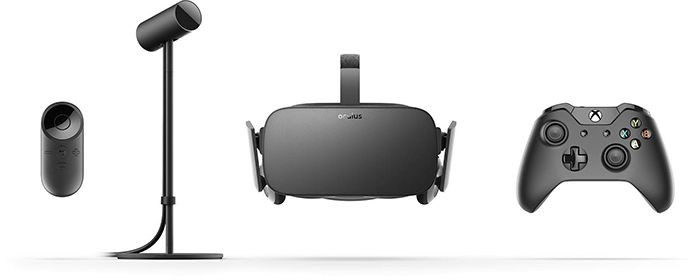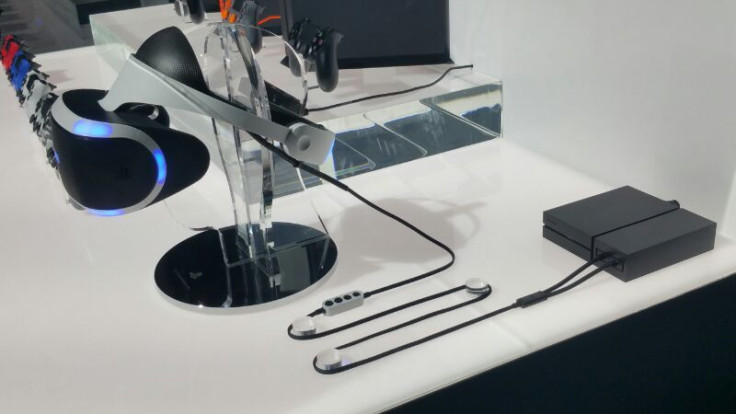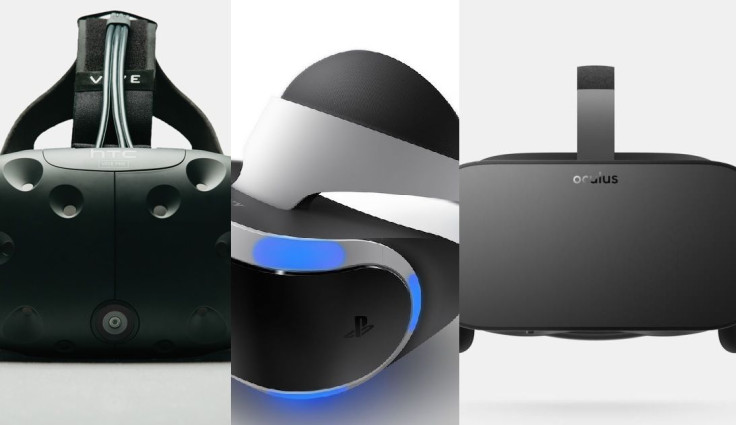We're less than a week into the new year but it has already become more than abundantly clear from CES that 2016 is the year of virtual reality. At the forefront of this new virtual reality wave are three trailblazing new products: Oculus Rift, HTC Vive, and PlayStation VR. Each offers its own unique interpretation of what virtual reality gaming has the potential to become.
But how exactly do these devices compare?
The Oculus Rift and HTC Vive are arguably the rivals in the industry given both are designed to be top-of-the-line PC-centric devices. Spec details are limited but Digital Trends shared a comparison chart based on the Oculus Rift consumer model and HTC Vive development kit.
For the most part, the Oculus Rift and the HTC Vive are closely matched, both of which boast an OLED display with 2160 x 1200 resolution (1080x1200px for each eye), a refresh rate of 90Hz, and a 110 degree field of view. The Oculus Rift also features numerous sensors including an accelerometer, gyroscope, magnetometer and 360-degree positional tracking via the Rift's Constellation tracking system, a single sensor mounted to a ten-inch stand.
The HTC Vive offers similar sensors, but forgoes the magnetometer and positional tracking, opting for a laser position sensor and front-facing camera to aid the user's sense of environmental awareness despite wearing the immersive VR unit. The front-facing camera, cleverly named the "Chaperone," is an especially clutch feature as our very own Marc Perton described during his test drive of the Vive, especially since neither the Oculus or the PlayStation VR has implemented this feature.
"At any time, a double-tap on a controller button brings up a real-world overlay on top of whatever you’re doing in the virtual space," said Perton. "While it might seem jarring to suddenly merge the virtual and the actual, HTC’s implementation makes it incredibly natural.
The laser position sensor is unique to the HTC as well, although this system requires the user to set up laser poles at the corners of the room for spatial calibration, which we've yet to determine whether it is a pro or con. On one hand, the laser positioning system offers a generous tracking area of 15 x 15 feet that potentially allow users more freedom to move around in a room versus the Oculus Rift, which will depend on the ability of the single constellation tracking sensor. On the other hand, the laser sensors might also make the HTC Vive a more cumbersome product that is more complicated to set up.
According to Oculus, the new Rift will require a graphics card that is equivalent or greater than the NVIDIA GTX 970 / AMD 290, a minimum 8GB RAM, compatible HDMI 1.3 video output, two USB 3.0 ports, and Windows 7 SP1 or newer OS. Given the identical display, resolution and refresh rate for the HTC Vive, we assume that the Vive requirements aren't far off.


Other features available on the Oculus Rift include built-in 3D audio and built-in mic, as well as an Oculus Touch remote and compatibility with the Xbox One controller. Meanwhile, the HTC Vive features a SteamVR controller but also promises compatibility with various PC gamepads. That said, the Vive does not have built-in audio just yet and has not announced built-in mic capabilities. From the demo videos we've seen on the web, users are wearing a set of headphones over the Vive unit, which means the user's will have the unique, and perhaps unfavorable, experience of having both their eyes and ears completely covered.
Pricing of the Oculus Rift will start at $599 with the first pre-orders shipped by the end of March. The HTC Vive price tag has yet to be announced, but despite the lack of built-in audio and built-in mic for now, the Vive certainly does not seem like an inferior product. It will be interesting to learn how the HTC Vive will be priced in the days ahead.
The PlayStation VR is dedicated to Sony's PlayStation 4 console, but comparisons between the Sony headset alongside its PC counterparts are inevitable. Like the Oculus Rift and HTC Vive, the PlayStation VR will arrive to the market at some point in 2016. What's more, the specs on the PlayStation VR are not far off either.

While both the Rift and Vive boast 2160 x 1200 resolution, the PlayStation VR will make do with 1920 x 1080 (960 x 1080 for each eye). That said, while the Rift and Vive offers a 90Hz refresh rate, the PlayStation VR can render games at up to 120Hz, which should translate to even better image movement fluidity. Next, the PlayStation VR also features a built-in 3D audio speaker design, which is similar to the Rift and not available in the Vive. However, there is one key aspect that suggests that the PlayStation VR isn't necessarily at the same level as its PC virtual reality counterparts.
Unlike the Oculus Rift's Constellation Positioning System and the HTC Vive's laser position sensor, the PlayStation VR will simply utilize the PlayStation Eye camera as the tracking system. Moreover, the PlayStation VR will pair with the Dual Shock 4 and the PlayStation Move motion controller as well. By syncing with existing peripherals rather than demand more hardware, this enables the PlayStation VR to position itself at a more affordable price range.
However, the PlayStation VR will also feature an external processor to ensure the PS4 will be able to handle the demanding virtual reality graphics, which could severely eliminate Sony's pricing advantage over Oculus and HTC. Specifics regarding the external processor are limited, but the processor is an add-on box "a bit smaller than the Wii" that plugs into the console. The headset in turn plugs into the external unit. The external processor also features an HDMI input and output for "social screen" functionality, which means it will allow other friends in the room to use the TV and PS4 to interact with, or simply watch, the person playing within the PlayStation VR.
Even if the external PlayStation comes at a premium, we cannot ignore that the Oculus Rift, and the HTC Vive by extension, demands premium PC hardware for the processing power necessary to run virtual reality. At the end of the day, the PlayStation VR is paired with Sony's current PS4 console, which currently retails for just $350, or approximately the same price as one Nvidia GTX 970 computer graphics card.
In that regard, the PlayStation VR should still offer a more affordable price point that can give Sony a significant leg up over the Oculus Rift and HTC Vive. What's more, the PS4 gaming console may also be better positioned for popular, mainstream virtual reality gaming content than the PC counterparts.
Ultimately, most of what we're saying is conjecture based on the information we have at this point and it's difficult to say which of the three VR devices are best until they actually reach the market. During a Reddit AMA session on Wednesday, Oculus Rift CEO Palmer Luckey noted that virtual reality technology is truly in its infancy right now that naturally leads to a discordance among the range of VR offerings.
"We are focusing on launching our own product right now," said Luckey. "but when standardization does eventually happen, it will be the result of collaboration between many companies, not control by a single company."


















